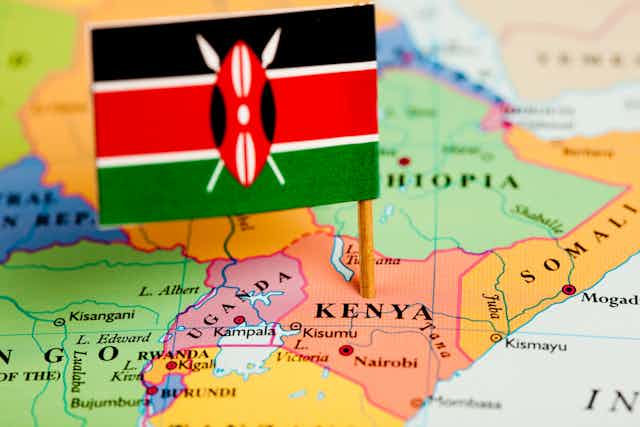Kenya’s opposition politicians recently called for secession – which is the withdrawal of territory and sovereignty from part of an existing state to create a new state. Led by Raila Odinga, who received 48.8% of the presidential vote in Kenya’s 2022 election, the politicians want the country split into two republics to create a new state for Kenyans unhappy with President William Ruto’s leadership.
Calls for secession are not a new political phenomenon in Kenya.
Even before the territory gained independence from Britain in 1963, some Kenyan Somalis had sought to secede and join neighbouring Somalia. And the Mombasa Republican Council, established in the 1990s, has called for an independent state for the coastal people, citing their marginalisation.
Opposition groups also made secession calls after Kenya’s 2007-08 post-election violence. These calls were repeated in the run-up to the elections in 2013. Then in 2017, a bill tabled in parliament proposed creating a People’s Republic of Kenya from 40 of the country’s current 47 counties. Geographically, this new republic would retain nearly 87% of Kenya’s population and 97% of the land mass, leaving behind a nation that would not be economically viable.
Secessionist movements around the world usually result from the belief by some groups within a region or state that they aren’t able to exercise their right to self-determination. This is their right to determine “their own future, political status and independence”, according to the UN.
Self-determination can be external or internal: full independence from other states, or access to political and social rights within a state. The two kinds are related. When governments fail to guarantee internal self-determination, affected groups may seek secession, or external self-determination.
The politicians calling for secession in Kenya argue that some Kenyans have been systematically deprived of the right to participate in the country’s government and economy.
Read more: Kenya's Muslims: a divided community with little political clout
Aggrieved groups may seek to form their own independent sovereign state, like the Biafrans of Nigeria did between 1967 and 1970. Or they may seek to join another independent state, as the Somalis of Kenya did in the 1960s.
In my view as a legal scholar and economist who has studied the political economy in Africa for close to two decades, any group in Kenya that unilaterally declares independence is unlikely to find support on the continent. Additionally, Kenyan politicians have yet to prove that aggrieved groups have been systematically denied the right to participate in the government and the economy in meaningful ways.
Colonial borders
The African Union has been against secession since it was first established as the Organisation of African Unity in 1963.
The organisation refused to intervene in the Nigerian civil war sparked by the Biafran secession of 1967, calling it an internal affair. And in Mali, in response to the declaration of the independent state of Azawad by northern Tuaregs in 2012, the union rejected this, terming it “null and of no value whatsoever”.
The union’s chairperson at the time, Jean Ping, emphasised the
fundamental principle of the intangibility of borders inherited by African countries at their accession to independence.
This echoes Article 4(b) of the Constitutive Act of the African Union. It states that the continental organisation shall respect the borders that existed at independence. The act also calls on the union to defend the territorial integrity of its member states. This presents it with a dilemma when it comes to addressing secessionist movements.
The answer to this dilemma is for the African Union to establish a legal mechanism for recognising legitimate struggles for secession. These include struggles that offer a remedy for grave and systematic injustices.
Read more: A breakdown of Biafra separatism, and where Kanu fits into the picture
This was seen in South Sudan in 2011. The South Sudanese people based their push to secede on the argument that since independence in 1956, Khartoum had systematically marginalised them and denied them the right to pursue their political, economic and social development within a united Sudan.
At the end of a brutal civil war (1985 to 2005), the warring parties signed a peace agreement. It granted southerners the option to pursue self-determination. Sudan approved of South Sudan’s independence push.
National governments can also establish constitutional processes that allow aggrieved groups to peacefully and constitutionally petition for separation. This has been done in the UK and Canada. Such constitutional mechanisms can encourage aggrieved groups to seek internal instead of external self-determination.
While secession can involve the use of force – as it did in Biafra and South Sudan – it can also be achieved through peaceful means. Scotland’s ongoing bid to become independent of Britain is a case in point.
Kenya’s obstacles
Secession by Kenya’s aggrieved groups or peoples is unlikely to succeed as it faces four major obstacles.
First, as is clear from the African Union’s Constitutive Act, any move to interfere with Kenya’s territorial integrity is unlikely to be supported by the organisation.
Second, it’s not likely that the post-secession state will gain the approval of the UN Security Council and then that of two-thirds of the UN General Assembly to be admitted to the UN. This is largely because the secessionists have not yet made a credible case for splitting Kenya into two states.
Read more: Ghana's secessionist conflict has its genesis in colonialism: it's time to reflect
Third, secession as envisioned by Kenya’s opposition will create two states, one of which is not likely to be economically viable. This could lead to a civil war.
Fourth, the 2010 constitution devolved power from the central government in Nairobi in favour of local communities in 47 regions. This significantly improved the ability of various groups to govern themselves and participate in their own economic, social and cultural development.
Politicians and aggrieved groups need to exercise the right to self-determination through this decentralised governance process. Through it, they can help create a participatory, inclusive and development-oriented government and economy in a united Kenya.

